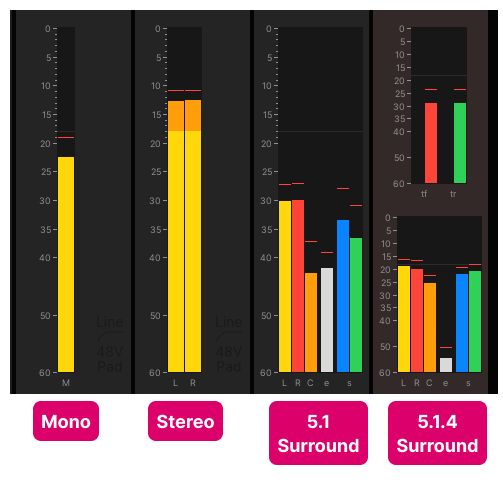mc²36 - Channel Formats
Any odd/even pair of DSP channels can be linked for stereo, and a range of channels can be configured for surround.
- Any type of channel can be configured to create stereo and surround inputs, groups, auxes and sums.
- The number of mono DSP resources required depends on the selected format.
- Once a stereo or surround bus is configured, the corresponding pan law is applied.
Stereo Channels
A stereo channel always uses two mono resources, and the channels must be odd/even; for example, you can link INP 3/4 or 5/6, but not 4/5.
Once a stereo channel is created, it can be placed in access and assigned to a single fader strip. The functionality is identical to that of a mono channel, with the following additional features:
- Stereo input control - left/right balance, left to both, right to both, left/right reverse, etc.
- Image - width and positioning.
- Downmix - the option to create a mono downmix (with summing level adjustment).
All other processing (EQ, Dynamics, Delay, etc.) is applied equally to both left and right sides.
For Groups, Auxes and Sums, you can use Reveal-in-place to temporarily reveal the left and right slave channels to two individual fader strips. This makes it possible to apply offsets to the left and right sides.
Surround Channels
For surround channels, the number of mono resources depends on the selected format: 6 resources for 5.1; 10 resources for 5.1.4, etc. The surround format can vary on a per channel basis. A wide range of 2D and 3D formats are supported (up to 9.1.6).
When a surround channel is created, a Surround VCA is automatically assigned. This allows you to control all of the component channels from a single fader strip, and apply changes to all legs. The functionality is identical to that of a mono channel, with the following additional features:
- Surround VCAs - multi-channel control from a single fader strip, with Channel Display metering of the surround slaves.
- REVEAL - can be used to reveal the surround VCA slave channels to individual fader strips (to apply offsets to the components).
- Hyper Pan - a panning tool for surround sources.
- 3D Pan - channel panning for 3D immersive formats.
- AMBIT - upmix and spatialise processing.
- Downmix - the option to create a stereo downmix (with summing level adjustment).
Surround channels can only be created in 8 or 16-channel blocks. For example, a 5.1 sum can be created from SUM 1-6 or SUM 9-14, but not SUM 7-12. This may mean that you need a higher number of mono resources in the DSP Configuration to meet the surround channel needs.
Identifying the Channel Format
The easiest way to identify stereo and surround channels is to look at the peak metering on the Channel Display. Here you will see an individual bargraph for each of the component channels. The screenshot below shows an example with four different channel formats: mono, stereo, 5.1 and 5.1.4.
